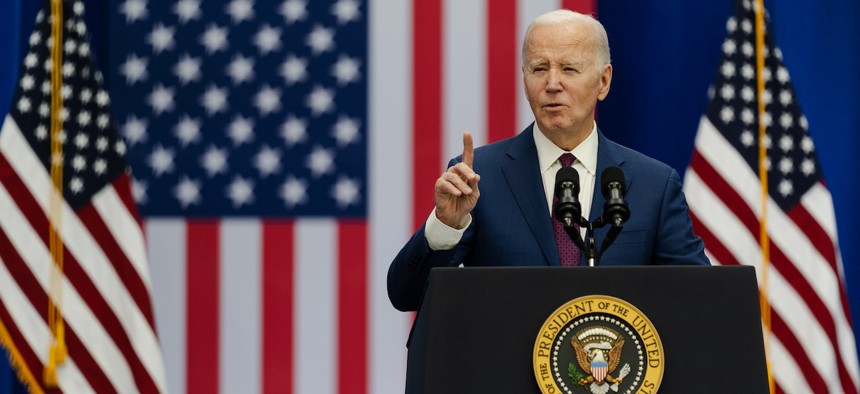These agencies would make the biggest workforce gains in Biden's scaled back 2025 budget

Most major federal agencies would still increase their rolls under the president’s proposed plan. Sophie Park/Getty Images
Several agencies have particularly ambitious growth plans, while some are seeking cuts.
President Biden is seeking only modest increases to the federal workforce in fiscal 2025, lowering the requests in his budget to align with spending caps he has signed into law.
Most major federal agencies would still be in line to increase their rolls under the president’s blueprint, though they would do so much less aggressively than Biden envisioned in his previous proposals. Overall, the civilian federal workforce would grow by just 1% under the latest White House document.
Much of the proposed hiring would continue to implement key agenda items for the Biden administration, such as seeking to boost resources at the border, dramatically ramp up tax enforcement and implement infrastructure spending. Other proposals would look to provide resources for agencies still looking to dig out of cuts they endured under the previous administration.
Some agencies that have long been in a hiring posture, such as the departments of Defense and Veterans Affairs, would see their workforces shrink. A few agencies are still adjusting to anomalous workforce changes. The Small Business Administration, for example, received a massive boost of resources during the height of the COVID-19 pandemic and the agency is continuing to right-size its staffing levels as those funds run dry.
Many agencies are hoping to receive assistance in their recruiting efforts and have asked for special hiring authorities. After helping to establish talent teams at every major federal agency, the Office of Personnel Management has now stood up a Hiring Experience Group to assist those teams in developing strategies to centralize recruiting and onboarding efforts within government.
Here is a look at every agency’s hiring plans and detailed explanations for some of the most significant initiatives:

Treasury still ahead
For the second consecutive year, President Biden is looking to grow the Treasury Department more than any other agency. The staffing boost would once again be driven by increases at the Internal Revenue Service as it looks to improve customer and service and increase enforcement thanks to funds from the Inflation Reduction Act. The agency is looking to extend its direct hire and streamlined critical pay authorities to ensure hiring delays are not an obstacle during IRA implementation.
IRS said it will have to shed 1,700 employees funded through its normal appropriations. It will add 9,400 workers using its IRA funds, however, leading to a net total of nearly 7,700 new employees. In total, by the end of fiscal 2025, IRS expects to have 26,000 employees on board funded through IRA accounts. That could lead to “funding cliffs” when those accounts run dry, the agency warned, leading it to request an extension and additional money. The agency is now requesting $104 billion over a 10-year period.
Transportation safety
The Federal Aviation Administration requested a 14% increase to its budget relative to fiscal 2023. It is looking to add 2,000 employees to its rolls in fiscal 2025, which the White House said would "rebuild the pipeline of new controllers needed to safely meet project air traffic demands." Lawmakers and the Biden administration are looking to lock in more significant growth as part of the still forthcoming FAA reauthorization bill. Elsewhere in the Transportation Department, the Federal Motor Carrier Safety Administration is looking to grow its workforce by 13%, which it said would—inconjunction with the 2021 bipartisan infrastructure law—improve roadway safety. The Federal Railway Administration is asking to boost its safety inspector to a new record level.
Reversing course at Social Security
The Social Security Administration said it expects to end fiscal 2024 with its lowest staffing level since 1972 and its proposal would allow it to at least return to the number of employees it had on board in fiscal 2023, while also increasing the use of overtime. Budget constraints have forced a hiring freeze that has devastated the agency, SSA said, leading to 750 fewer employees at its call centers and 2,100 fewer employees at its field offices.
“This loss of staff will negatively impact call wait times, disability timelines, and other key performance metrics and be felt by the people we serve,” new SSA Commissioner Martin O’Malley said, adding the agency could lose as many as 4,500 employees in fiscal 2024.
If the workforce levels do sink that low, SSA would look to add about 5,000 employees in fiscal 2025.
Reversing course at VA
For many years, the Veterans Affairs Department has sought to grow its workforce dramatically. Since 2019, the department has added more than 72,000 employees. It made significant leaps in fiscal 2023 and the start of fiscal 2024, but officials now say they will only add staff in targeted areas. At some facilities, VA has paused hiring or revoked offers. In fiscal 2025, VA anticipates actually shedding about 10,000 employees. Most of the losses will come from the Veterans Health Administration, though the Veterans Benefits Administration is proposing it lose 4% of its workforce. VA officials have said its recent hiring success means it has the workforce it needs to carry out its mission, though its workload is increasing as its implements the PACT Act.
Energy
The Energy Department’s hiring would give Energy an overall staffing increase of 18% since fiscal 2022 and it would see the second-largest growth of any major agency in Biden’s budget.
The National Nuclear Security Administration would bring on hundreds of new employees, leading to a 12% bump after initial results from a new workforce plan demonstrated a need for additional staff. The Federal Energy Regulatory Commission would increase its workforce costs by 13% to improve reliability oversight, provide cybersecurity services and boost data analytics capabilities.
Border Security
The Biden administration used its fiscal 2025 budget to once again push for an emergency funding surge to address immigration and border concerns. The funding would allow the Homeland Security Department to hire 1,300 additional Border Patrol agents to secure the border, 1,000 additional Customs and Border Protection officers and 1,600 asylum officers within U.S. Citizenship and Immigration Services. It would also allow the Justice Department to hire 375 new immigration judge teams.
Outside the supplemental request, the White House proposed funding to hire 350 Border Patrol agents, 310 processing coordinators, 150 CBP officers and 25 immigration judge teams. DHS is looking to add a total of more than 11,000 employees.
Rebuilding Interior
The Interior Department saw its workforce shrink by 6% during the Trump administration, one of the biggest reductions during his presidency. By the time he left office, its workforce level reached a 10-year low. The department has been slow to recover, though fulfilling its fiscal 2025 budget request would amount to a 9% growth since the end of 2020. It vowed to “recruit, hire, and train the next generation of talented people who will reflect the diversity and strength of the United States.” It has received authority to use extended term appointments for implementation of the 2020 Great American Outdoors Act and to direct hire for permitting positions. It maintains the expedited hiring authority for firefighting, IT and STEM positions.
The Bureau of Indian Affairs would see its workforce grow by 12%, while the Fish and Wildlife Service requested a 5% increase. Headquarters staff, meanwhile, would experience a nearly 10% reduction.
Violent crime agents
The Justice Department requested $1.2 billion over five years to stand up a new Violent Crime Reduction and Prevention Fund, which it said would allow the FBI, Bureau of Alcohol, Tobacco, Firearms and Explosives and U.S. Attorneys Officers to hire violent crime agents and prosecutors. ATF would bring on more forensic examiners, while the Drug Enforcement Administration and U.S. Marshals Service would also boost their rolls. All told, Justice would net 3,500 employees.
NEXT STORY: Biden's $1.67 trillion budget boosts tech, AI






